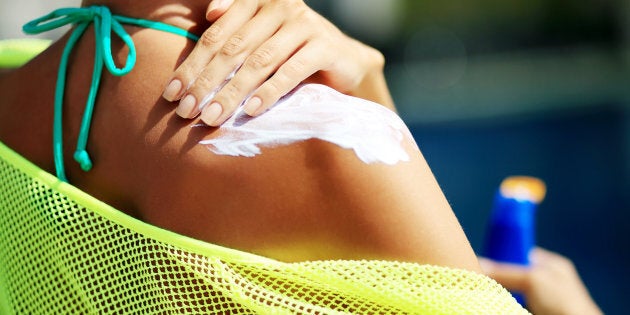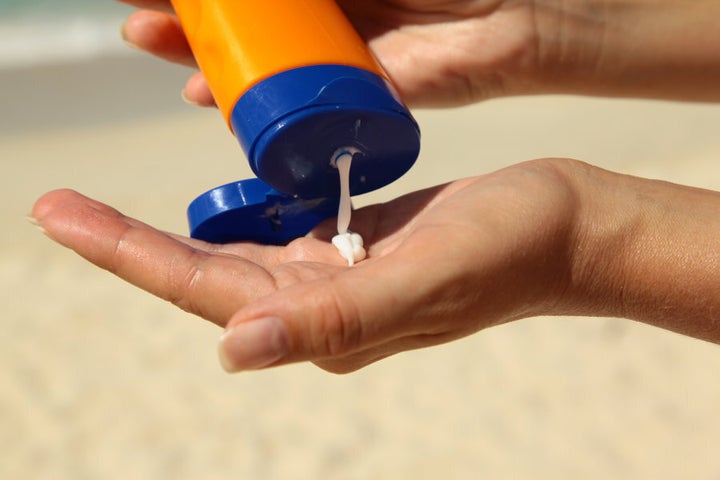
For most of us, our sunscreen routine is pretty straightforward.
Some of us will apply it every day of the year -- rain, hail or shine. Others will (hopefully) chuck some on as they head out into the scorching summer heat.
Enter the 'chemical versus physical sunscreen' debate, which has been circulating lately and things get a little more confusing. Which one is more protective? What does nanotechnology have to do with it? And should you be making the switch?
Amid all the questioning and the jargon, clinical associate professor and dermatologist Saxon Smith says we're missing the point.
"This discussion can be broken down into absorbent versus reflector and things become a bit clearer," he told The Huffington Post Australia.
Let us explain.
Chemical versus physical: what's the difference?
Simply put, chemical sunscreens are those that contain chemicals. We're talking things like Octylcrylen, Avobenzone and Octinoxate. Physical sunscreens use natural agents like zinc and titanium oxide.
"The chemical ones are those absorbers whereby UV rays enter the skin, are absorbed and come out usually as infrared rays. They change the electromagnetic radiation effect," Smith said.
"The physical ones are reflectors and they do just that: they form a protective layer on the skin and reflect those UV rays."
Sunscreens can, and do, include both types of these active ingredients.
Which one is better?
Chemical sunscreens are easier to find -- and you're probably using one. Chemical filters offer more coverage against UVA and UVB rays, but tend to be more irritating on the skin.
You'll also be familiar with that thick, white slick of sunscreen that nobody is friends with. Yep, that tends to be physical sunscreen.
And whilst its mineral makeup lends physical sunscreen to being more natural and skin-friendly, discussion typically revolves around the adverse effects of nanotechnology that goes into making (and improving) it.
"People get confused when they hear about nanotechnology and they think it involves those chemical absorbers. It doesn't. We're just talking about physical reflectors," Smith said.
"Due to their make up, zinc oxide and titanium oxide give off that ghosting effect that people don't like about sunscreen. As a result, it becomes a barrier to using it.
"Nanotechnology is used to grind up these agents into smaller nanomolecules. This makes it more aesthetically pleasing to put on and it still gives us the protection that we want."

Does this pose any damage?
Both sunscreen kinds are effective (when applied correctly) and safe. When it comes to physical sunscreens and nanotechnology, we know this because the Therapeutic Goods Administration -- the body that regulates sunscreen in Australia -- has told us so.
"The potential for titanium dioxide and zinc oxide nanoparticles in sunscreens to cause adverse effects depends primarily on the ability of the nanoparticles to reach viable skin cells," a statement earlier this year from the TGA read.
To date, evidence suggests otherwise: "Rather, these remain on the surface of the skin and in the outer layer of the skin that is composed of non-viable cells."
Cancer Council Australia has delivered a similar message:
"Our assessment, drawing on the best available evidence is that nanoparticles used in sunscreens do not pose a risk. However, we continue to monitor research and welcome any new research that sheds more light on this topic."
Which one should I be using?
According to Smith, it all comes down to your situation and circumstance.
"Some people react to different components contained in any moisturiser or cream because of some form of allergic contact dermatitis, so they will choose what works for them," Smith said.
And there's certainly crossover.
"There tends to be more physical blockers in ranges of childrens sunscreen and the absorbers tend to be in others. Again, there's nothing wrong or different about them -- it's just about finding what works best for you."
What matters is ensuring broad spectrum protection (from both UVA and UVB rays) and using whatever you choose diligently.
Click below to follow HuffPost Australia on Snapchat!
